
 Search Here
Search Here
MISC
Parts List
Robot Forum
Chat
Member Pages
Axon MCU
Robot Books
Shop
Contact
SKILLS
How To Build
A Robot
Tutorial
Calculators
Mechanics
Programming
Miscellaneous
Robots
Space
HARDWARE
Actuators
Batteries
Electronics
Materials
Microcontrollers
Sensors
SCIENCE
Robot Journals
Robot Theory
Conferences
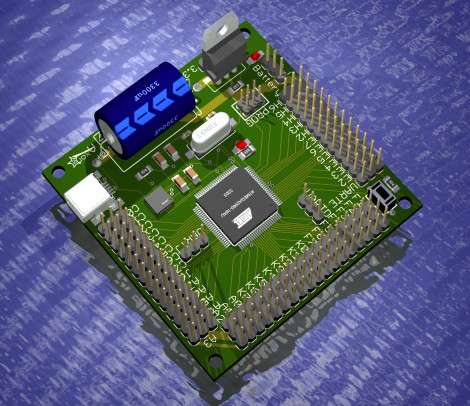
Want to make pretty 3D images of your circuits?
. . . while simply using your already designed 2D Eagle board files?
I thought so. Enjoy my Eagle3D tutorial!
Preface on Eagle
For those still in the dark ages, Eagle CAD is
a automated software design tool to create professional PCB circuits.
I have no plans as of the moment to write a tutorial on how to use Eagle, as there are already quite a few tutorials on the web:
Instructables Eagle tutorial 1
Instructables Eagle tutorial 2
University of Florida Eagle tutorial
Sparkfun Eagle library
Creating Eagle Parts Tutorial
Eagle Export Tutorial
After you have designed your circuit, you would probably next want to view the propagated PCB in 3D for both verification and cool-looking presentations. This is where we will start.
Eagle3D
When I first started using Eagle3D,
it quickly became apparent that the documentation
seemed to have forgotten that whole 'how do I use the software?' bit . . . I wasted several hours trying to figure it out . . .
And I'm sure many others have as well . . .
But thankfully you have this tutorial, so it should only take you about 10 minutes =)
Step 1
Download the Eagle3D software (1.6mb).
Install the software using the installer. I installed it here:
C:\Program Files\Eagle3D
but it doesn't actually matter where.
Step 2
Open up your board file in Eagle. In the command bar, type 'run':
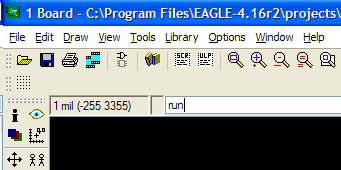
A new window will come up asking you to find a .ulp file. Browse into your Eagle3D directory (where you installed it) and select the file 3d41.ulp. Now select your language, and then browse for the output file (it will only ask you this once).
Step 3
Next, a new window will now pop up:
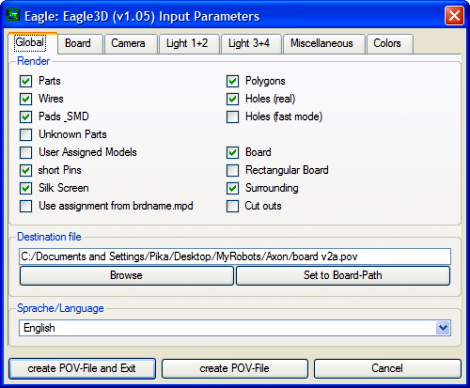
There are tons of options here, such as shadowing, camera angles, lighting, coloring, etc. Don't worry about them for now - the defaults will give you decent results. But you may want to play around with it in the future to get that 'perfect' look.
A highly suggested modification would be to rotate the board some. I like to change the Y:
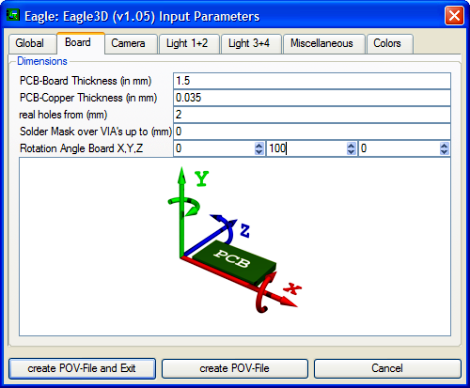
Click create POV-File. This will take a few seconds to process. There is a good chance it will ask you various questions about your board components - answer as best you can.
After processing is complete, you will now have a .pov file. You are halfway done!
Now you need a post-processor to convert that .pov into a pretty picture . . .
Step 4
Install the 32-bit version
POV-Ray (9.7mb)
software. If you want more information on this impressive software,
feel free to visit the POV-Ray website.
Install the software, and load it up. Click on the Open file icon, and locate your .pov file created in the previous step:
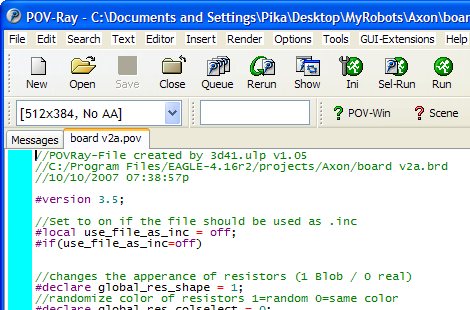
Step 5
We need to point POV-Ray to the .inc files for Eagle3D. These files define the 3D
electronics components that will propagate your PCB.
Click Tools -> Edit master POVRAY.INI
A notepad file should load up. At the very bottom of it, add this line:
Library_Path="C:\Program Files\Eagle3D\povray"
Make sure the directory points to where you installed Eagle3D. Now save and close the file.
Step 6
In POV-Ray, click the Ini icon so that we can select an image size. The larger the image,
the longer the processing time. When designing the board I like to use a low resolution,
but when I have the final product I'll do the maximum size. The max size on my laptop takes
less than 5 minutes to process, not too long - but it really depends on how complex the board is.
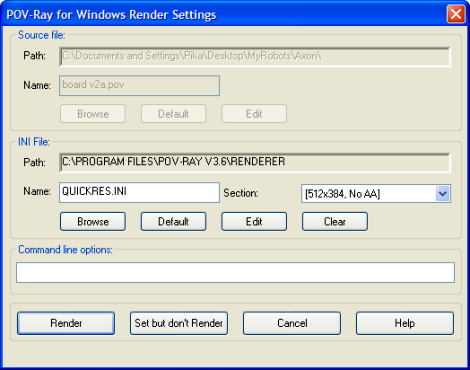
Use the section: drop-down menu to select your preferred size. Including AA will give you smoother better looking images, but will also double the processing time. (see below for an example)
When you are all ready to go, push the Render button. Immediately this 'error' message will pop-up. Just push OK and ignore it. It won't happen again.

Step 7
Now if you did everything right, an image should pop up and slowly propagate:
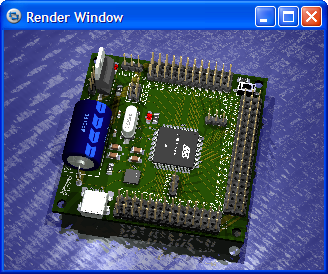
(jagged edges without AA)
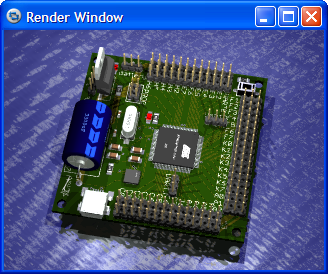
(better quality with AA)
Feel free to change the camera angle and image sizes.
Adding Components to Eagle3D, Step 8
Now chances are not all components have shown up on the board.
This is where it gets tricky and so I'll do my best to help you out.
There is also a good (bad?) chance you will have to do a little programming, too.
First, click the Open file button in POV-Ray. Locate and open the file user.inc in the Eagle3D\povray folder.
Next, click Open again, and change Files of type: to All Files (*.*). Locate and open the file 3dusrpac.dat in your Eagle3D folder.
By default, both of these files should be blank.
Step 9
In the file 3dusrpac.dat, add this as ONE line:
PACKAGE_NAME:0:1:0:0:0:0:0:0:0:0:0:0:0:0:0:0:0:0:0:0:0:0:0:0:0:0:0:0:0:0:MACRO_NAME(::
Now we need to change PACKAGE_NAME and MACRO_NAME to actual values.
To find the PACKAGE_NAME, first go back to your schematic page on Eagle, click the info button, then click a component that is missing in the 3D image:
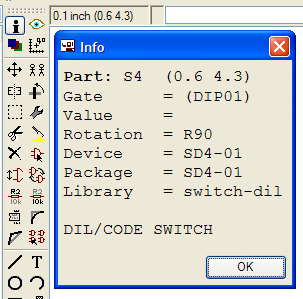
Replace PACKAGE_NAME with the Package variable. In this case it is SD4-01. Note that this is always in caps!
Step 10
Next, we need to find a MACRO_NAME to match your missing part as closely as possible.
First you need to locate a part that looks like what you need (or close to it). Download the Eagle3D image library (36mb) and unzip it into a folder. Set the folder options to thumbnail view so you can see them all. Locate a matching component (or as close as possible), and copy the file name onto your clipboard (minus the .png file extension).
Lets say hypothetically you choose CON_DIS_MATNLOK_9263_13_1 which looks something like this:
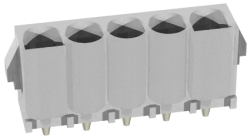
Once again, using the Open dialog in POV-Ray, go into your Eagle3D\povray and locate the file connector.inc because you needed a connector. If you needed a switch instead, you would use switch.inc. Etc.
Search the connector.inc file for the part name. You will find this:
#macro CON_DIS_MATNLOK_9263_13_1()
object{CON_DIS_MATNLOK_9263_GRND(5,1)}
#end
Copy this code exactly and paste it in the user.inc you opened earlier. You will need to add the word value in the parenthesis and the union{} thing:
#macro CON_DIS_MATNLOK_9263_13_1(value)
union{
object{CON_DIS_MATNLOK_9263_GRND(5,1)}
}
#end
Now back to the 3dusrpac.dat, replace MACRO_NAME with CON_DIS_MATNLOK_9263_13_1
to get this:
SD4-01:0:1:0:0:0:0:0:0:0:0:0:0:0:0:0:0:0:0:0:0:0:0:0:0:0:0:0:0:0:0:CON_DIS_MATNLOK_9263_13_1(::
Now go back to the beginning of this tutorial, recreate the .pov file, and render your image again. If you did everything right, your new component should appear.
Just say Yes, Reload in POV-Ray:

Step 11 - The hard step!!!
Now suppose the selected component isn't exactly the right dimensions . . . well now you are asking
to modify the program for that component found in connector.inc. Programming is outside the scope
of this tutorial, but feel free to check out this
POV-Ray Tutorial.
Now I'm definitely no professional programmer, but I will tell you it took me only about two hours of brain frying (guessing until it worked) to create my first part. And I didn't use the tutorial. Play with it for a bit and you will figure it out. Basically all you are doing is defining color, texture, and coordinates of basic shapes.
Oh, and you will probably notice that the source code has a lot of German in it. So if you are awesome like me and can't read German, translate it!
One hint of useful advice. You may notice that your components placed on the PCB are rotated or translated wrong. Easily solved. For our earlier example, in the connector.inc file locate the macro and right before the #end add these lines:
//add numbers in millimeters to translate the part translate <0,0,0> //add angles to rotate the part rotate <0,0,0>
Now for those who don't want to bother programming and have a CAD program, see step 12.
Step 12 - Convert a 3D CAD .stl file to .pov (Optional)
Suppose you don't want to bother programming to create shapes in .pov, and
instead just want to convert you CAD files (from another program) into .pov code.
This can potentially save tons of time!
First, using your preferred CAD program, save your CAD file as a .stl. This file type is an industry standard.
Next, download this small .stl to .pov conversion utility. For more info and source code, feel free to check out the stl2pov homepage. Unzip the file.
Next, open up a command prompt window (click start->Run..., then type 'cmd', push OK):
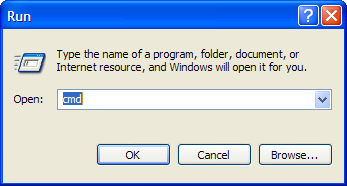
Go in to the stl2pov directory:
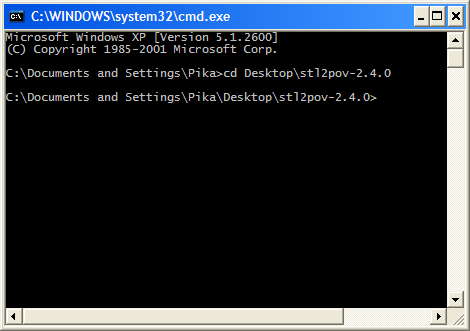
Then type 'stl2pov input.stl >output.inc', where input is the name of your .stl file and output is the desired output pov file. Optionally, you can also type 'stl2pov input.stl|more' for more stuff. Push enter.
note: in v3.0, do not use the > character.
Wait until its done. You now have a .inc file you can use with any macro. Just make sure that its included:
Go back to Step 5 to add
this line in POVRAY.INI:
Library_Path="C:\Documents and Settings\Pika\Desktop\stl2pov-2.4.0"
(wherever the output.inc file is)
To view your new file and/or to include it, load up POVRay, select the New icon, and paste this code into it:
#include "output.inc"
background {color rgb 1}
light_source {<-100,1000,-1000> rgb 1}
global_settings {
assumed_gamma 2
}
camera {
orthographic
location <10,10,-10> scale 0.2
look_at <2,0,2>
}
object {
m_ascii
texture {
pigment {color <1,0,0>}
finish {phong 0.5}
}
}
Save this new DrawSTL.pov file wherever.
Now just Render it as described in Step 6 and higher.
To add it to your PCB, in user.inc add this:
//custom CAD STL
#macro MICRO_SD_GRND(value)
union {
#include "output.inc"
object {
m_ascii
//texture{col_silver}
texture
{
pigment {color <1,1,1>}
finish {phong 0.5}
}
}
translate <-14,15,-2>
rotate <90,0,0>
}
#end
#macro MICRO_SD(value)
object{MICRO_SD_GRND(value)}
#end
Society of Robots copyright 2005-2014
